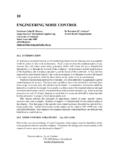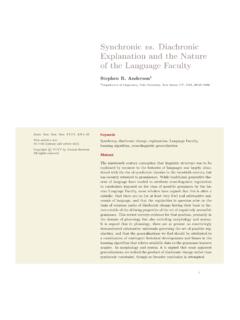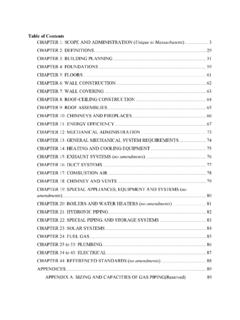Transcription of IS LANGUAGE UNIQUE TO THE HUMAN SPECIES? - …
1 IS LANGUAGE UNIQUE TO THE HUMAN SPECIES? by Ulla HedeagerINTRODUCTIONThe assertion that humans differ from animals in their use of LANGUAGE hasbeen the subject of much discussion as scientists have investigated LANGUAGE useby non- HUMAN species . Researchers have taught apes, dolphins, and parrotsvarious systems of HUMAN -like communication, and recently, the study of animallanguage and behaviour in its natural environment rather than in the laboratoryhas increased. It is my aim to discuss HUMAN LANGUAGE within an evolutionaryperspective, to step across disciplinary boundaries of different fields of science,and to show how we may consider LANGUAGE only as one of the many forms thatanimal communication has taken and that it may not be out of reach of otherspecies. WHAT IS LANGUAGE ?What is LANGUAGE ? A universally accepted definition of LANGUAGE or thecriteria for its use does not exist.
2 This is one of the reasons for the disagreementamong scientists about whether non- HUMAN species can use LANGUAGE . In naturewe find numerous kinds of communication systems, many of which appear to beunique to their possessors, and one of them is the LANGUAGE of the HUMAN , the purpose of communication is the preservation, growth, anddevelopment of the species (Smith and Miller 1968:265). The ability to exchangeinformation is shared by all communication systems, and a number of non- HUMAN systems share some features of HUMAN LANGUAGE . The fundamentaldifference between HUMAN and non- HUMAN communication is that animals arebelieved to react instinctively, in a stereotyped and predictable way. Mostly, HUMAN behaviour is under the voluntary control, and HUMAN LANGUAGE iscreative and unpredictable. It is generally assumed that only humans of the problem of differentiating man from the other animals is theproblem of describing how HUMAN LANGUAGE differs from any kind ofcommunicative behaviour carried on by non- HUMAN or pre- HUMAN species .
3 Untilwe have done this, we cannot know how much it means to assert that only manhas the power of speech. (Hockett 1967:570). In order to contrast humanlanguage with animal communication, the linguist Charles Hockett (1967:574-580) introduces a generally accepted check list for LANGUAGE , a set of designfeatures that all HUMAN languages possess. His seven key properties are: dualityof pattern (the combination of a phonological system and a grammatical system),productivity (the ability to create and understand new utterances), arbitrariness(when signs/words do not resemble the things they represent),interchangeability (the ability to transmit and to receive messages by exchangingroles), specialization (when the only function of speech is communication andthe speaker does not act out his message), displacement (the ability to refer to theIS LANGUAGE UNIQUE TO THE HUMAN species ?)
4 2past and to things not present), and cultural transmission (the ability toteach/learn from other individuals, by imitation). Until recently, articulatespeech was also considered crucial to LANGUAGE , and the visual grammar of signlanguages was not studied or recognized as true famous view of LANGUAGE is that of the influential Noam assumes that a kind of LANGUAGE organ within the mind is part of the geneticmake-up of humans. A system which makes it possible from a limited set of rulesto construct an unlimited number of sentences is not found in any other species ,and Chomsky believes that it is an investigation of this uniqueness that isimportant and not the likeness between HUMAN LANGUAGE and othercommunication systems (Wardhaugh 1993:18-26,60-65). Apparently, linguistsshould not be concerned with this question because it is outside their field, and itis outside their field because the linguists themselves have defined LANGUAGE asuniquely HUMAN .
5 This approach does not operate within an evolutionaryperspective and does not consider LANGUAGE within its natural social ages, philosophy and religion have established mans place in nature,and humans tend to regard nature as the raw material they exploit andmanipulate to suit their purposes, not something they should communicate any case, without having intensively investigated any form of animalcommunication that may resemble HUMAN LANGUAGE , combinations ofwords/signs, intonation, and body- LANGUAGE , within a natural social context, wecannot claim that LANGUAGE is UNIQUE to the HUMAN DOES HUMAN LANGUAGE COME FROM ?Where does HUMAN LANGUAGE come from? LANGUAGE , being an efficienthuman adjustment to the environment, evolved by natural selection. This seemsindeed the most likely scientific explanation, and unless we believe in a divineorigin, there should be no reason to reject a Darwinian point of view.
6 Assumingthat new species would emerge when an adaptive variation improved theirsurvival capacity (Wardhaugh 1993:34-36), Darwin argued that the theory ofnatural selection could explain the evolution of instincts, too. The instincts ofanimals are prewired in the nervous system, and some of the brain cells, featuredetectors, respond to certain kinds of stimuli (Wardhaugh 1993:100-102).Similarly, LANGUAGE is prewired in the nervous system of humans, and thehuman speech detectors are responding to LANGUAGE . Thus we may regard theChomskyan LANGUAGE organ as a LANGUAGE instinct (Pinker 1995:17-20).Supporting the Darwinian theory, the embryology reveals structuralresemblances between the embryonic stages of quite different species ,descending from a common ancestor from whom they have inherited thesealmost identical stages (Parker 1995:43-50).
7 Other important complements are thestudies of genetics, the discovery of the cell nucleus containing chromosomesand a genetic code revealing a common pattern that is shared by all organisms(Husen, Petersen, and Sonne-Hansen 1983:128), the studies of homologousanatomy, and the comparative studies of the molecular structure of LANGUAGE UNIQUE TO THE HUMAN SPECIES? 3In Eric Lenneberg's view (Smith and Miller 1968:219-225) LANGUAGE has abiological foundation. He argues that the HUMAN organism matures according toa fixed maturational process, and that LANGUAGE develops in children during thisperiod. The earliest sounds of a HUMAN infant are stimulus controlled (Fromkinand Rodman 1998:319-328). It has a mammalian larynx that can rise, enablingconcurrent breathing and eating, and not until the age of three months are itsspeech organs ready for producing vowels (Pinker 1995:354).
8 Around the age ofsix months the infant begins to experiment with sounds, and soon after it beginsto babble in syllables and to imitate intonation patterns. One year old it producesone-word utterances and sentence-like gibberish, and around eighteen monthsthe first two-word utterances occur (Pinker 1995:265-268). The first utteranceslonger than two words consist of open-class words carrying the main telegraphic speech is supposed to represent the grammar at that particularstage of the childs LANGUAGE development. Perhaps linguistic accomplishmentslike babbling, first words, and grammar require minimum levels of brain size,long-distance connections, and extra synapses, particularly in the languagecentres of the brain. (Pinker 1995:289). LANGUAGE acquisition may be like other biological functions, and thedifferences between the pre-linguistic and post-linguistic stages are caused bythe maturation of the individual.
9 HUMAN brain growth is incomplete at birth. Thebrain-maturation process of all other species reach the adult state at a quickerpace, and the HUMAN brain differs in appearance as it has more surface folding ofthe cortex (Smith and Miller 1968:239-245). Nature tends to improve on formermodels and processes by building new structures upon the old ones. Mammalsand birds descend from reptiles, and the structures of the reptiles brain are stillpresent as the central parts of the adult HUMAN brain as the development of thehuman brain is an enormous enlargement of the cerebral cortex which is barelyvisible in the reptiles brain (Ellegaard 1982:25-31). The brains of all higheranimals are divided into two cerebral hemispheres, and research has shownhemispheric lateralization in humans and other species , too: The control of songis strongly lateralized in the left hemispheres of many birds, and the productionand recognition of calls and squeaks is somewhat lateralized in monkeys,dolphins, and mice.
10 (Pinker 1995:306). In the left hemisphere of the HUMAN braintwo areas of the cerebral cortex have been identified as important for LANGUAGE (Nathan 1982:226-230). Neurologists have observed that people with damage tothese parts of the brain show specific LANGUAGE difficulties. Wernicke's areaappears to be essential for understanding and producing words, Brocas area tobe important for grammar and sentence production. In most people these areasare larger in the left hemisphere than in the right hemisphere. Gannon,Holloway, Broadfield, and Braun (1998:220-222) have examined the areacorresponding to Wernicke's area in chimpanzees in order to determine if theirbrain structures show the same asymmetry between the LANGUAGE is considered UNIQUE to humans, it has been widelyassumed that the asymmetry, in particular in Wernicke's area, was also UNIQUE tohumans and that chimpanzees lacked the structures necessary for languagedevelopment.
















